Annual Flowers That Bloom All Summer Long (With Pictures)
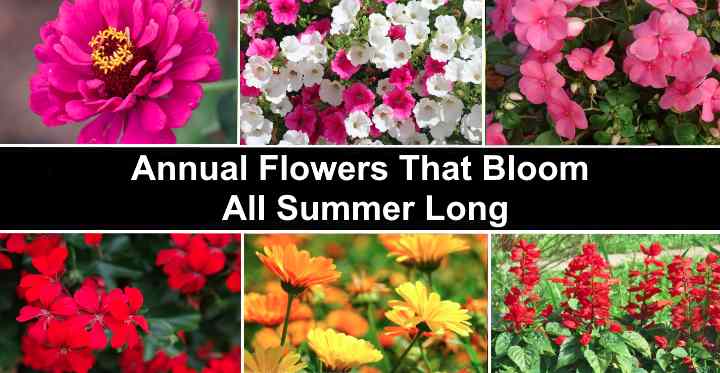
Annual flowers that bloom all summer long are perfect for adding continuous color and beauty to your garden. Flowers that complete their life cycle in one year offer a tremendous variety of vibrant colors and textures to enhance garden landscapes. Long-blooming annual flowers like petunias, begonias, calendula, snapdragon, and daisies bloom continuously from spring to fall. These easy-grow annual flowers provide a stunning display of flowers throughout the summer season.
Do you want to add a burst of color and life to your garden this summer? This article has a list of the best annual flowers that bloom all summer long. You will also find some excellent tips on growing annuals that bloom from spring until the frost.
What Are Annual Flowers that Bloom Throughout the Summer?
Annual summer-blooming flowers complete their life cycle in one year, whereas perennial flowers live for several years. Annuals typically flower and die off within a single season. However, they provide a stunning display of vibrant colors in gardens throughout summer. Unlike annual flowers, perennials come back year after year and bloom at different times depending on the species.
Many flowering plants grow as annuals in temperate climates, but in warmer climates, they are classified as perennials. Some tender perennials that grow as annuals include lantana, wax begonias, verbenas, impatiens, and zinnias.
Annual Flowers That Bloom All Summer Long (With Pictures)
Please read on to learn about the best annual flowers to plant in your front or backyard to enjoy colorful blooms throughout the summer.
Marigold (Tagetes)

Marigolds are popular annual flowers that bloom throughout the summer, renowned for their vibrant and bright colors. Often referred to as French marigolds, these long blooming annuals produce spectacular blossoms in shades of yellow, orange, and red shades, with options for both single and double blooms. Typically reaching a height of 6” to 12” (15 – 30 cm), these cheerful flowers require minimal maintenance and thrive in full sun.
Marigolds serve as ideal bedding plants, borders, or container flowers, enhancing the visual appeal of any garden. Their blooming period extends from early summer until the arrival of the first frost. To ensure continuous and abundant flowering throughout the growing season, deadheading is recommended. Furthermore, marigolds play a crucial role in attracting beneficial insects such as bees and butterflies to your garden.
USDA Zone: 2 to 11
Sun Exposure: Full sun
Soil Type: Well-drained, moderately fertile soils
Petunia (Petunia x hybrida)
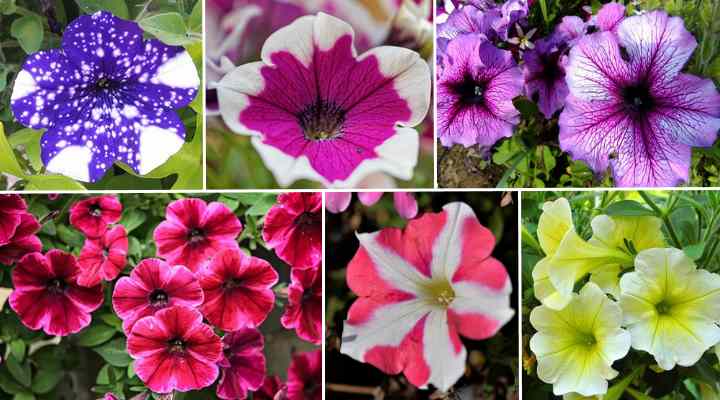
Petunias are reliable annual flowers that bloom continuously all summer, right up until frost. The showy, long-blooming flowers bloom in pink, purple, white, yellow and red shades. The annual plant is known for its vibrantly colored funnel-like flowers and soft green, ovate leaves. Petunias grow up to 6” (15 cm) tall.
Petunias are full sun flowering plants that will continue to bloom throughout the summer when provided with consistently moist soil. They are low-maintenance and can tolerate various soil conditions with good drainage.
Petunias are versatile plants for growing in flower beds, hanging baskets, or containers. Petunia flowers are a great choice for adding a splash of color to any garden or landscape to create colorful borders, foundation plantings, or growing along a fence line.
Petunias are the easiest and quickest blooming flowers to grow from seed.
USDA Zone: 9 to 11
Sun Exposure: Full sun to light shade
Soil Type: Well-drained soils
Zinnia (Zinnia elegans)

Zinnia is a group of popular annual flowering plants known for their vibrant colors and long-lasting summer blooms. The showy ray flowers bloom in a wide variety of colors, including red, orange, yellow, pink, and purple. The daisy-like blooms on tall stems and lanceolate leaves make them versatile for adding color to any garden.
Zinnias are easy-to-grow, full-sun annual flowers that reach heights of 1 to 4 ft. (0.3 – 1.2 m). They are drought-tolerant and can withstand hot summer temperatures. With their bright and cheerful blossoms, zinnias are often used in flower beds, borders, and containers. They also make great cut flowers and can be enjoyed indoors in bouquets and arrangements
USDA Zone: 2 to 11
Sun Exposure: Full sun
Soil Type: Well-drained soil
Common Geranium (Pelargonium)

Common geraniums are easy-to-grow tender flowering perennials that are typically cultivated as annuals, blooming throughout the summer. These popular flowering plants produce vibrant, colorful flowers in umbels (clusters). They exhibit continuous blossoming from spring until fall, and in warmer climates, they can even bloom throughout the entire year. Geraniums generally reach heights between 6” and 24” (15 – 60 cm).
Geraniums are vibrant, colorful flowers in various shades of red, pink, purple, and white. The long-blooming flowers are often fragrant and attract pollinators like bees and butterflies. Additionally, they are easy to grow and require minimal maintenance. Regularly deadheading spent flowers and watering regularly encourage continuous blooming in summer and fall.
You can grow geraniums in mixed plantings, garden borders, window boxes, and hanging baskets.
USDA Zone: 9 to 12
Sun Exposure: Full sun to partial shade
Soil Type: Well-drained soil
Wax Begonia (Semperflorens-Cultorum Group)
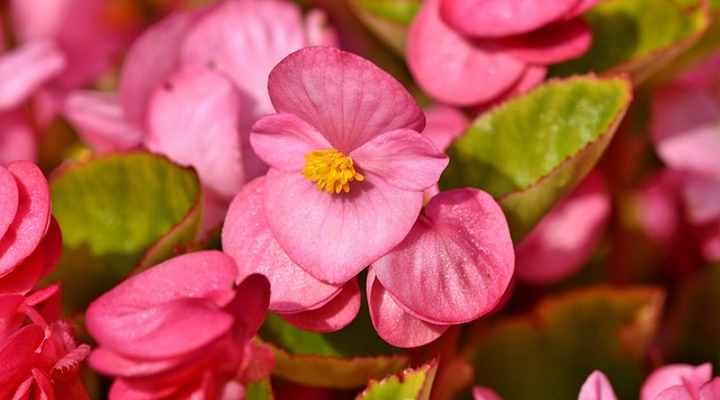
Wax begonias bloom throughout the summer and are perfect landscaping annuals to add colorful blooms and glossy foliage to a yard. This compact plant is grown as an annual in temperate regions. The bedding plants thrive in mixed borders, containers, window boxes, or planted along pathways. They grow up to 12” (30 cm) tall.
Wax begonias bloom from May through September in various colors, including pink, red, white, and bi-colors. They are low-maintenance plants, drought-tolerant, and thrive in a wide range of well-drained soil types. They are a great choice for adding color to shady areas of the garden or for brightening up containers and hanging baskets.
USDA Zone: 9 to 11
Sun Exposure: Dappled sunlight to partial shade
Soil Type: Humus-rich, well-drained, moderately fertile soil
Scarlet Sage (Salvia splendens)

Scarlet sage or red sage is a popular annual flower known for its vibrant red blooms throughout the summer. The tall spikes of long-blooming red tubular flowers add a bold splash of color to any garden or landscape. Red sage flowers can also appear in shades of pink, purple, blue, and lavender.”annual
Red sage leaves are green and lance-shaped. Scarlet sage grows up to 12” to 24” (30 – 60 cm) tall. It’s a low maintenance tender perennial that is grown as an annual in colder climates. This prolific summer-blooming, clump-forming plant produces vibrant red flowers from late spring until frost. Scarlet sage is ideal for borders, flower beds, mass plantings, and containers to create a striking visual display.
USDA Zone: 10 to 11
Sun Exposure: Full sun
Soil Type: Well-drained, humus-rich soil
Impatiens (Impatiens walleriana)
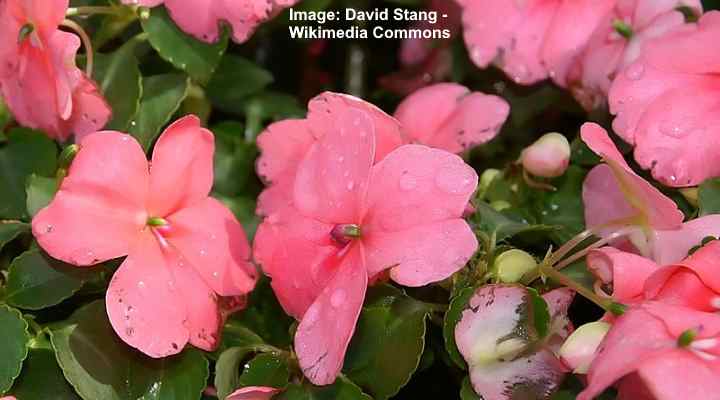
Impatiens, also known as busy Lizzies, are popular tough and hardy annual flowers that bloom all summer long. These popular bedding plants have a dense, mounding, or clumping habit. Impatiens bloom with trumpet-shaped flowers in pink, red, white, peach, and apricot colors. The vibrant flowers contrast with the lance-shaped deep green leaves.
Impatiens are shade-loving plants, popular for their ability to add a splash of color to shady gardens. The eye-catching flowers bloom continuously throughout the summer. Impatiens grow 12” to 24” ft. (30 – 60 cm) tall. The tender perennials perform well in flower beds, borders, hanging baskets, and containers.
Impatiens colorful floral displays attract pollinators like bees and butterflies to gardens.
USDA Zone: 10 and 11
Sun Exposure: Dappled sunlight, partial shade, or deep shade
Soil Type: Well-drained, fertile soils with high organic matter
Cosmos (Cosmos bipinnatus)

Cosmos is a group of half-hardy annual flowers with colorful, delicate blooms that last an entire summer. The daisy-like pink, white, red, and purple flowers bloom at the end of tall, wiry stems. They have a long blooming period, typically throughout summer until fall. Cosmos plants can grow up to 4 feet (1.2 m) tall.
Cosmos flowers are easy to grow and require minimal care. The flowering annuals grow 12” to 36” (30 – 90 cm) tall. Due to their summer-long blooming period and easy growth, they are popular landscaping annuals for flower beds, borders, mass plantings, and containers. Cosmos annual flowers are also ideal for butterfly gardens.
USDA Zone: 2 to 11
Sun Exposure: Full sun
Soil Type: Well-drained soil
Verbena (Verbena x hybrida)
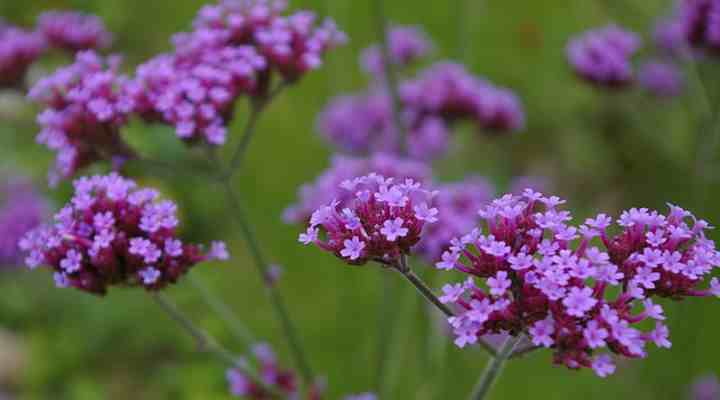
Verbena is a versatile annual flower known for its long-lasting summer blooms and vibrant colors. The clusters of dainty five-petalled flowers bloom in shades of pink, purple, red, white, blue, and multi-colors. The long-lasting flowers bloom in rounded 3” (7.5 cm) clusters between lush green foliage.
Verbena plants typically grow 6” to 12” (15 – 30 cm) tall and have a spreading habit up to 24” (60 cm). The beautiful annuals are popular for planting in flower beds, borders, hanging baskets, and containers to add continuous color to a garden landscape throughout the summer.
Verbena flowers are also great for adding color to rock gardens and slopes.
USDA Zone: 8 to 11
Sun Exposure: Full sun or partial shade
Soil Type: Well-drained sandy or loamy soil
Nasturtium (Tropaeolum majus)

Nasturtium plants produce vibrant annual trumpet-shaped flowers with five overlapping petals. The showy funnel-like flowers bloom all summer from late spring until fall, filling yards with yellow, red, mahogany, creamy white, and orange colors. The leaves have a unique, easily-identifiable shape, like a round, green parasol. The showy, colorful flowers can be single or double blossoms.
With its sprawling, creeping stems, nasturtiums are ideal for hanging baskets and containers. You can also plant them as annual ground cover for full sun. The creeping annuals perform well in mass planting, rock gardens, and edgings.
Nasturtiums grow 12” to 18” (30 – 45 cm) tall and have a climbing habit, making them great for covering pergolas, arbors, and unsightly fences. Nasturtiums are easy to grow, are drought-tolerant, and grow as short-lived perennials in tropical climates.
USDA Zone: 9 to 11
Sun Exposure: Full sun to partial shade
Soil Type: Well-drained soil
Calendula (Calendula officinalis)

Also known as pot marigold, calendula is a versatile annual flower with bright blooms that last all summer from spring until fall. This spectacular summer bloomer has daisy-like flowers in yellow, orange, and apricot shades. The decorative flowers add a burst of color to any garden throughout the whole of summer.
Calendula plants need direct sunlight to produce their stunning summer flowers. The plants grow 12” to 24” (30 – 60 cm) tall and have bright green, lance-shaped leaves. They are easy to grow and require minimal maintenance. You can plant calendula as annual flowers in flower beds, borders, and containers, where their vibrant colors will brighten gardens for several weeks in the summer.
USDA Zone: 2 to 11
Sun Exposure: Full sun
Soil Type: Moderately fertile, well-drained soil that is consistently moist
Moss Rose (Portulaca grandiflora)

Moss rose is a low-growing annual flower with colorful cup-shaped blooms appearing from spring to frost. Also known as sun rose, the annual plant has needle-like succulent leaves and vibrant flowers consisting of crepe paper-like petals. The brightly colored summer blooms can be pink, red, salmon, orange, yellow, white, and bi-colors.
Moss rose flowers open during the day and close at night, creating a beautiful display of color throughout the summer. The drought-tolerant, ground-hugging plants grow 3 to 6” (7.5 – 15 cm) tall and spread out to form a dense mat of foliage and flowers up to 24” (60 cm) wide.
Sun rose flowers are excellent for adding color to sunny areas of the garden. They are hardy annuals that thrive where other flowers may struggle to grow. Portulaca flowers suit border fronts, edgings, or ground cover in full sun. They also perform well in hanging baskets and containers.
USDA Zone: 2 to 11
Sun Exposure: Full sun
Soil Type: Well-drained soil, sandy or loamy soil
Treasure Flower (Gazania rigens)

Treasure flowers are long-blooming, colorful annual flowers that add vibrant touches to gardens throughout summer. The spectacular annuals have yellow and deep orange daisy-like flowers with many colorful cultivars. These ray-like orange flowers have 20 petals and measure up to 4” (10 cm), blooming on the top of long stems.
Showy, long-lasting treasure flowers are drought-tolerant and thrive in the summer heat. The orange-yellow flowers brighten gardens planted as mass plantings, edgings, or along borders. Treasure flowers are ideal for flower beds, containers, and ground cover.
With their bright and cheerful blooms, treasure flowers are a beautiful addition to any garden.
USDA Zone: 9 to 11
Sun Exposure: Full sun
Soil Type: Average soil with excellent drainage
African Daisy (Arctotis)
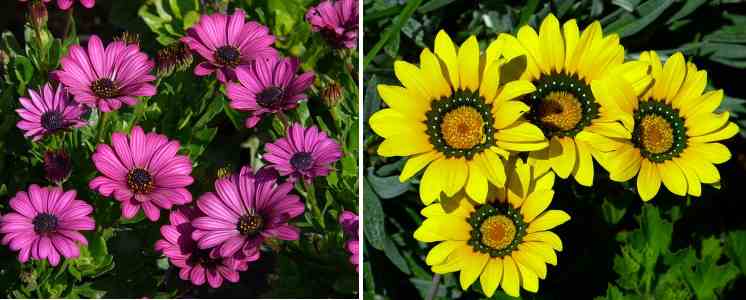
African daisies usually begin blooming in late spring, and their flowers continue through summer until the first frost. The ray flowers have black or yellow central disks surrounded by linear, pointed petals. These colorful flowers come in a wide range of colors, including pink, yellow, orange, purple, and white, and contrast nicely with the green leaves. The daisy-like flowers measure 3” (7.5 cm) across.
African daisies grow in compact mounds measuring 12” to 24” (30 – 60 cm) tall and 12” (30 cm) wide. Although they are considered annual flowers that bloom all summer, they may stop blooming in the hottest regions during the peak of summer. These flowering annuals are ideal for containers, rock gardens, or borders.
USDA Zone: 2 to 11
Sun Exposure: Full sun
Soil Type: Sandy, consistently moist soil that drains well
Lantana (Lantana camara)

Lantana is a tropical flowering plant that produces continuous summer blossoms. Growing as an annual in cooler climates, lantana flowers are eye-catching clusters of small, brightly colored tubular flowers. The blossoms come in shades of red, orange, yellow, pink, and purple. The fragrant flowers attract butterflies and hummingbirds.
In temperate climates, you must plant lantana annually in spring to enjoy their unusual colorful flowers for months on end. The brightly colored flowers contrast nicely with lush, glossy green leaves. You can plant them as ground cover, in mixed borders, or hanging baskets. They also perform well in containers to add a pop of color to a patio.
The shrubby, hardy plants grow 12” to 24” (30 – 60 cm) tall.
USDA Zone: 8 to 11
Sun Exposure: Full sun
Soil Type: Slightly acidic, well-drained soil
Sweet Alyssum (Lobularia maritima)
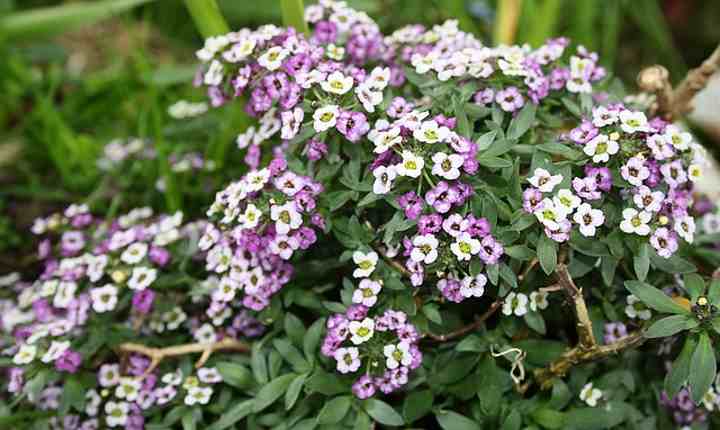
Sweet alyssum is a popular annual flower with clusters of delicate, fragrant blooms filling summer gardens. The small, delightfully scented flowers come in shades of white, deep pink, lavender, and purple. Low-growing sweet alyssum plants grow 8” (20 cm) tall and 12” (30 cm) wide.
Sweet alyssum is a versatile annual flower with many uses in a landscape. You can plant the mat-forming plant as ground cover or fill in empty spaces in flower beds and borders. It also looks beautiful, cascading over the edges of containers and hanging baskets. Sweet alyssum is a great choice for adding a splash of color to rock gardens and pathways.
USDA Zone: 2 to 11
Sun Exposure: Full sun to partial shade, with afternoon shade necessary in the hottest climates
Soil Type: Well-drained soil with medium moisture
Snapdragon (Antirrhinum majus)

Snapdragons are annual flowers with a prolonged blooming time lasting the entire summer season. Snapdragon flowers bloom in floral spikes in pink, red, orange, yellow, and white shades. The colorful snout-shaped flowers grow on tall spikes that reach up to 3 ft. (1 m) tall.
Snapdragons are easy-growing flowering annuals ideal for adding vertical interest to gardens. The long-lasting blooms appear in spring and persist to fall. You can plant the stunning flowers in beds, borders, along edges, or as foundation plantings. They also perform well in window boxes and containers.
USDA Zone: 5 to 10
Sun Exposure: Full sun to partial shade
Soil Type: Chalky, loamy, or sandy, well-drained soils
Summer Snapdragon (Angelonia)

Summer snapdragon is a bushy flowering plant that is often grown as an annual. Identifying features of this long-blooming annual are its snapdragon-like flowers, lance-shaped dark green leaves, and grape-like fragrance. The colorful annual flowers bloom in showy upright spikes of flowers in shades of purple, pink, blue, and white.
Summer snapdragon plants grow 1 to 3 ft. (0.3 – 1 m) tall and 2 ft. (0.6 m) wide. The summer annual flowers are heat and drought tolerant and can withstand hot summer temperatures. Blooming from late spring to early fall, the flowers produce long-lasting color for the whole summer.
You can plant summer snapdragons in flower beds, containers, and borders. Summer snapdragons also make great cut flowers, adding beauty to bouquets and arrangements.
USDA Zone: 9 to 11
Sun Exposure: Full sun
Soil Type: Evenly moist, well-drained soils
Firecracker Plant (Cuphea ignea)
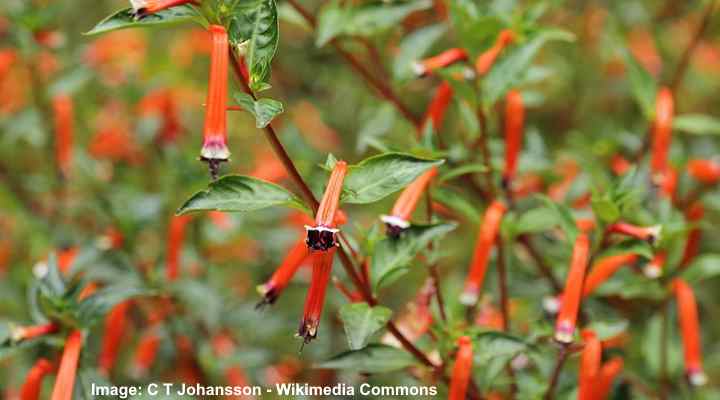
Also known as the Mexican cigar plant, the firecracker is a long-blooming tender perennial that can be grown as an annual. Bursting into color in spring and lasting through summer, this small plant blooms with reddish-orange tubular flowers. The eye-catching blossoms resemble tiny firecrackers or cigars, hence the common names.
Firecracker plants grow 1 to 3 ft. (0.3 – 1 m) tall. The tropical evergreen shrub is characterized by glossy green lance-shaped leaves and freely-blooming red flowers. The dwarf shrubs are low-maintenance and drought-tolerant and can withstand hot summer temperatures. Firecracker plants are ideal for adding vibrant color to borders, containers, and hanging baskets.
USDA Zone: 9 to 11
Sun Exposure: Full sun
Soil Type: Well-drained soil
Tickseed (Coreopsis tinctoria)

Tickseed is a hardy annual flower that produces bright and cheery blooms from early summer to fall. The attractive annual is identified by yellow and reddish-brown daisy-like flowers on long stalks, feathery foliage, and non-stop summer flowers. Tickseed plants grow 2 to 4 ft. (0.6 – 1.2 m) tall.
Tickseed is a low-maintenance flower with continuous summer blooms. You can grow the yellow-flowering wildflower in cottage gardens, along borders, or in mass plantings for season-long color and texture.
USDA Zone: 2 to 11
Sun Exposure: Full sun
Soil Type: Well-drained soil that is dry to medium moisture
Pansy (Viola x wittrockiana)

Pansies are vibrant annual flowers that bloom throughout the summer months and well into the fall. The showy flowers are characterized by multi-colored petals in shades including blue, purple, red, white, and yellow. Popular as bedding plants for shaded gardens, the cheerful blooms have a unique face-like pattern on their petals, adding to their charm.
Pansies enjoy a long-flowering season, with many varieties blooming in early summer and lasting until early fall. The summer annuals grow 6” to 8” inches (15 – 20 cm) tall. Apart from being popular bedding plants, pansies grow well in containers and hanging baskets and brighten borders with pastel shades.
Pansies are also on the list of ground cover plants with red flowers.
USDA Zone: 5 to 9
Sun Exposure: Full sun, partial shade, deep shade
Soil Type: Well-drained, fertile, acidic soil that is amended with compost or manure
Globe Amaranth (Gomphrena)

Globe amaranth is a popular annual plant with long-lasting globe-shaped flowers that bloom all summer long. The continuous summer flowers create a sea of vibrant purple, pink, red, white, and orange shades. Globe amaranth blooms from early summer to fall, making it a long-lasting addition to any garden.
Globe amaranth plants grow up to 24” (60 cm) tall. The unusual flowers look like fuzzy round balls, and the leaves are lance-shaped. These hardy annual plants thrive in cottage gardens, beds, and borders. Its colorful flowers make excellent additions to fresh or dried cut flower arrangements.
USDA Zone: 2 to 11
Sun Exposure: Full sun
Soil Type: Moderately fertile, well-drained soil
Paris Daisy (Argyranthemum frutescens)

Paris daisies, also known as marguerite daisies, are perennial flowers that are often grown as annuals. These daisies feature large, white, or yellow flowers with a yellow center. They bloom profusely from spring through summer and into the fall, attracting bees and butterflies to the garden. Paris daisies grow between 12” and 24” (30 – 60 cm) tall and have dark green, fern-like foliage.
These low-maintenance daisies can thrive in various soil types as long as they are well-drained. They are also drought-tolerant and can withstand hot summer temperatures. Paris daisies are commonly used in flower beds, borders, and containers to add a touch of elegance to any garden.
USDA Zone: 9 to 11
Sun Exposure: Full sun to partial shade
Soil Type: Well-drained soil
Dianthus (Dianthus caryophyllus)
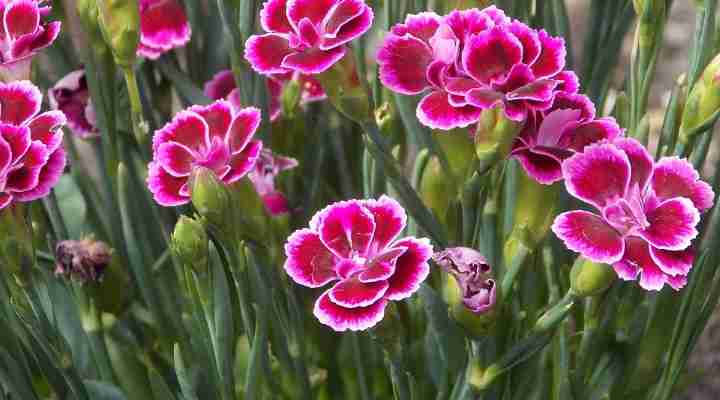
Dianthus—also known as carnations—are popular short-lived perennial flowers grown as annuals with a long-blooming season beginning in early summer. These beautiful fragrant flowers have fringed petals and grow in clusters on tall stems. Blooming through summer and fall, the showy flowers can be pink, red, white, or multi-colored.
Dianthus plants typically grow up to 12” (30 cm) tall. The easy-to-grow annuals require minimal maintenance to bloom throughout summer. However, deadheading spent flowers will encourage continuous blooming up until the first frost.
Dianthus flowers are versatile annual plants that brighten flower beds, borders, rock gardens, and containers. They also make great cut flowers for fragrant indoor bouquets and floral arrangements.
USDA Zone: 5 to 9
Sun Exposure: Full sun or partial shade
Soil Type: Well-drained neutral to alkaline soils
Gerbera Daisy (Gerbera jamesonii)

Gerbera daisies are popular annuals with large daisy-like blooms that flower from late spring through summer. The large flowers are basal rosettes with linear petals forming colorful rays. The long-lasting gerbera daisy blooms are vibrant pink, red, white, coral, orange and yellow flowers. Gerbera daisies grow on long stems with green, lobed leaves.
Continuously blooming in the summertime, gerbera daisies make a stunning addition to any garden. These enchanting daisy flowers are tolerant of hot summer temperatures and drought conditions. You can plant gerbera daisies in flower beds, borders, containers, and cut flower gardens.
USDA Zone: 8 to 11
Sun Exposure: Full sun to partial shade
Soil Type: Organically rich, well-drained soil that has medium moisture
Plumed Cockscomb (Celosia argentea)
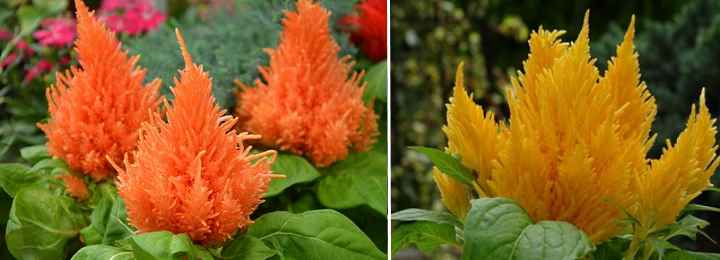
Plumed cockscomb is an annual flowering plant that can be grown as a perennial in warm tropical zones. It blooms all summer from late spring to first frost, with beautiful feathery flowers in bold colors such as yellow, pink, red, orange and purple-magenta.
Plumed cockscomb grows 1.5 to 2 feet (45 – 60 cm) tall and grows well in full sun and rich, moist, well-drained soil. With its tropical origin, the plant thrives in heat and humidity. The attractive flowers attract pollinators and beneficial insects and are great as cut flowers and foundation plants.
USDA Zone: 2 to 11
Sun Exposure: Full sun or partial-sun
Soil Type: rich, moist, well-drained soil, but tolerates poor, dry soil
Spider Flower (Cleome hassleriana)

Spider flowers are annual plants prized for their tall, showy, fragrant flowers that bloom from early summer to late fall. The unique flowers sit on long, slender stems. The clusters of delicate, spidery-shaped flowers are composed of four elongated petals that curl back like spider legs, surrounding a prominent central stamen.
Spider flowers add a unique touch to any sunny garden. The clusters of pink, purple, or white flowers nicely complement the airy, feathery foliage. After flowering, the spidery flowers are followed by ornamental seed pods. Long-blooming spider flowers grow 3 to 6 ft. (1 – 1.8 m) tall.
USDA Zone: 2 to 11
Sun Exposure: Full sun
Soil Type: Drought tolerant in dry to medium moisture soils with excellent drainage
Four O’Clocks (Mirabilis jalapa)

Four o’clocks are fragrant, colorful annual flowers that bloom throughout summer and to late fall. The strong, sweetly-scented tubular trumpet-like flowers bloom in a wide range of colors, including pink, red, white, yellow, and bi-colors. A feature of the annual plant is that its flowers open in late afternoon , around 4 p.m.—hence the name “four o’clocks.”
Four o’clocks are easy to grow and can reach a height of 2 to 3 feet (60 – 90 cm). They are drought-tolerant annuals and can thrive in a variety of soil types. These versatile flowers are excellent landscaping plants for cottage gardens, flower beds, borders, and large containers.
USDA Zone: 9 to 11
Sun Exposure: Full sun to partial shade
Soil Type: Well-drained, moist, acidic soil
Cupflower (Nierembergia hippomanica)

Cupflower is a compact long-blooming annual flower that produces delicate, cup-shaped blooms during summer and fall. The star-shaped, saucer-like flowers have a yellow center and petals in white, blue, lavender, and purple shades. Cupflower plants grow 6” to 12” (15 – 30 cm) tall and have a spreading habit.
Cupflowers are versatile annuals used in flower beds, borders, containers, and hanging baskets. Due to its sprawling nature, it’s also a great annual flowering plant for rock gardens, edging plants, and ground cover or growing in hanging baskets.
Cupflowers have a long blooming period, which typically lasts until fall. Therefore, they are ideal for adding a pop of color to your summer garden.
USDA Zone: 7 to 10
Sun Exposure: Full sun or part shade
Soil Type: Well-drained, fertile soil
Million Bells (Calibrachoa)
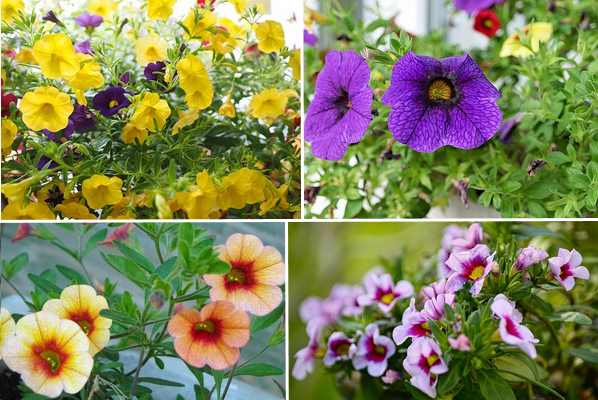
Million bells is a compact and trailing annual plant with stunning funnel-shaped flowers that last from spring to frost. The small trumpet-like flowers look like miniature petunias. They feature deep, vibrant colors, including pink, red, orange, yellow, and purple.
Million bells flowers are perfect for containers, hanging baskets, and window boxes, where their cascading flowering stems add vibrancy to outdoor spaces. The vigorous flowering annual is free-blooming all summer and fall.
Million bells plants grow up to 6” to 12” (15 – 30 cm) tall and spread up to 24” (60 cm) wide. Thanks to their long blooming period, the flowers are perfect for adding continuous color to balconies, patios, and garden borders all summer.
USDA Zone: 9 to 11
Sun Exposure: Full sun and partial shade
Soil Type: Well-drained soil
White Lace Flower (Orlaya grandiflora)

White lace flower is a white-flowering annual plant that produces eye-catching lacy blooms during summer and fall. The annual flowers have intricate, lace-like petals giving them a unique and elegant appearance. Its compact, bushy habit makes white lace flowers ideal for landscaping compact spaces. It grows 2 to 3 ft. (0.6 – 1 m) tall.
White lace flowers are easy to grow and can tolerate drought conditions. You can plant this annual plant in flower beds, borders, city gardens, and cottage gardens. The white blooms are popular for wedding bouquets and floral arrangements as they stay fresh in a vase for up to ten days.
Pictures of white lace flowers show they are like lace-cap hydrangea flowers. They have small central florets surrounded by larger, pure white petals.
USDA Zone: 2 to 11
Sun Exposure: Full sun
Soil Type: Well-drained soil
Madagascar Periwinkle (Catharanthus roseus)
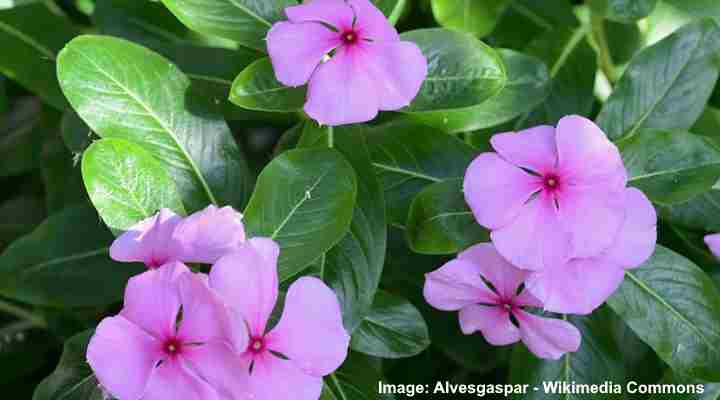
Madagascar periwinkle is a popular annual plant that adds pastel colored flowers to your garden all summer—right from late spring until fall. The annual plant has five-petalled, trumpet-like pink, white, red or purple flowers. The glossy green leaves and vibrant flowers make this plant a beautiful addition to any garden or landscape.
Madagascar periwinkle flowers bloom continuously from spring to fall, attracting butterflies and bees to the garden. Common uses of the annual plant include planting in flower beds, borders, ground cover and containers in hot and dry climates.
USDA Zone: 10 to 11
Sun Exposure: Full sun to partial shade
Soil Type: Organically rich, well-draining soil
Floss Flower (Ageratum houstonianum)

Floss flowers are popular annual flowers that produce clusters of small, fluffy blooms from late spring through summer until late fall. The clump-forming half-hardy annual plant has clusters of fluffy purple flowers that can also be pink, white or blue. Due to its low-growing nature, floss flowers are ideal for borders, rock gardens, or containers.
Drought-tolerant floss flowers grow 10” to 12” (25 – 60 cm) tall and have soft, hairy leaves.
USDA Zone: 2 to 11
Sun Exposure: Full sun to partial shade
Soil Type: Well-drained soil
Painted Tongue (Salpiglossis sinuata)

Painted tongue is a beautiful herbaceous annual flower with vibrant, trumpet-shaped blooms. Blooming from summer to frost in cool climates, the wide-throated funnel flowers come in stunning purple, yellow, pink, lavender, and red colors. The showy petals also have intricate veining patterns.
These annual flowers are easy to grow and are perfect for adding color to flower beds, borders, and containers. Painted tongue plants grow up to 12” (30 cm) tall.
USDA Zone: 2 to 11
Sun Exposure: Full sun or partial shade
Soil Type: Rich, moist, well-drained soils
Viper’s Bugloss (Echium vulgare)

Viper’s bugloss is an upright annual flowering plant with a long blooming time from spring to fall. Also known as blueweed, the stunning blue flowers grow in cylindrical spikes, reaching up to 36” (90 cm) tall. Due to its drought tolerance, the hardy annual is ideal for xeriscaping or low-water gardens.
You can also grow viper’s bugloss in flower beds, borders, or wildflower meadows to add a splash of color and attract beneficial insects.
USDA Zone: 3 to 8
Sun Exposure: Full sun to partial shade
Soil Type: Dry to medium moisture soils that have excellent drainage
Wishbone Flower (Torenia fournieri)

Wishbone flower is a popular annual flower with trumpet-like bi-color flowers that bloom freely throughout summer and fall. The stunning white and purple, or white and pink flowers, contrast nicely with the light green, oval leaves. Wishbone flowers grow up to 6” to 12” (15 – 30 cm) tall and have a spreading habit.
Wishbone flower is a shade-loving annual plant with a long blooming time. You can plant wishbone annual flowers to decorate containers, hanging baskets, window boxes, and borders.
USDA Zone: 2 to 11
Sun Exposure: Partial shade to full shade
Soil Type: Evenly moist, well-drained soils
Devil’s Trumpet (Datura metel)

Devil’s trumpet is a unique and exotic white-flowering plant with large, trumpet-shaped flowers blooming in summer and fall. Typically grown as an annual, the white flowers on this shrub have a distinct honeysuckle fragrance. The fast-growing annual grows 3 to 4 ft. (1 – 1.2 m), is drought-tolerant and can withstand hot temperatures.
You can plant the devil’s trumpet in a garden as a focal point to give it a tropical feel. The flowering annual also performs well as container plants on patios and balconies.
However, it’s important to note that all parts of the datura plant are toxic if ingested, so caution should be taken when planting and handling this plant.
USDA Zone: 9 and 10
Sun Exposure: Full sun
Soil Type: Organically rich, well-draining soils
Indian Blanket (Gaillardia pulchella)
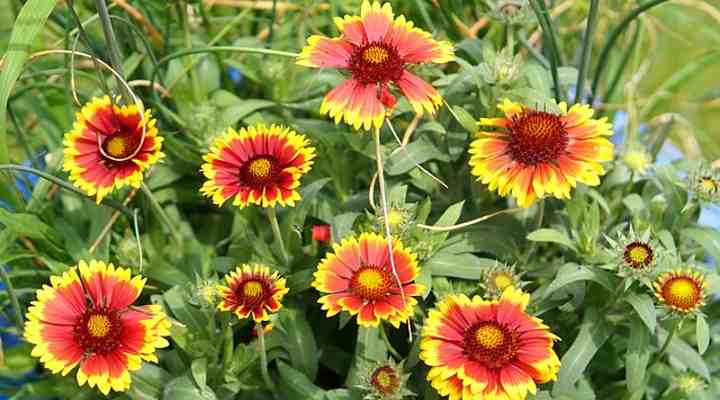
Indian blanket is a beautiful annual flower native to North America. The stunning yellow and red daisy-like summer flowers provide continuous color in landscapes thanks to their long-blooming time. The easy-grow, heat-tolerant wildflower is a great addition to sunny borders, butterfly gardens, borders, and mixed beds.
Indian Blanket flowers bloom from late spring to early fall and grow 12” to 24” (30 – 60 cm) tall. Their tolerance to drought and heat makes them excellent desert plants for warm climates.
Indian blanket flowers attract pollinators like bees and butterflies, adding beauty and life to any garden. In warm climates, Indian blanket is a short-lived, self-seeding perennial. In colder climates, it’s an annual flowering plant that fills gardens with continuous summer blossoms that last until fall.
USDA Zone: 2 to 11
Sun Exposure: Full sun
Soil Type: Dry to medium moisture soils with excellent drainage
Related articles:
